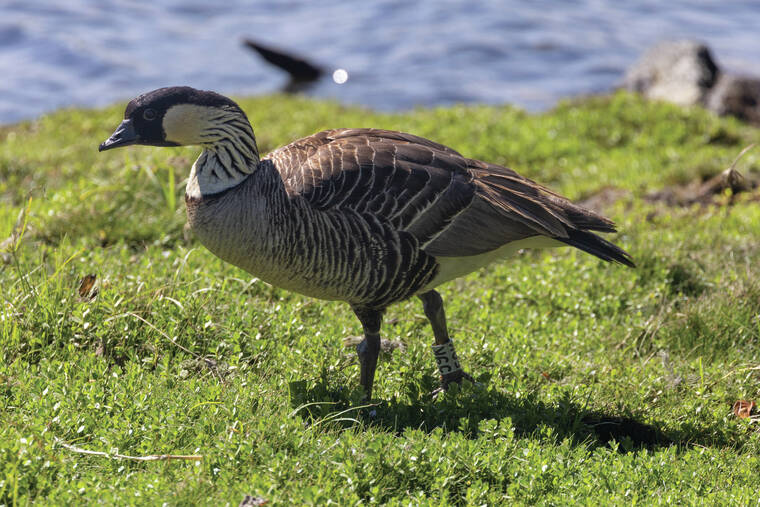The male nene, 59K, and his gosling are doing well after being relocated from Keaukaha to the Kipuka ‘Ainahou Nene Sanctuary last weekend.
Raymond McGuire, biologist for the Department of Land and Natural Resources Division of Forestry and Wildlife, or DOFAW, spent part of Wednesday walking around the nene sanctuary and saw 59K, or Kamali‘u, and his gosling getting more comfortable with their new setting near Maunakea.
The two nene were moved from Lokowaka Pond in Keaukaha last Saturday after 59K’s mate, C10, was struck and killed by a driver the night before.
“Usually, we don’t want to interfere with the nene and where they choose to stay. We don’t want to move them, since they are wild animals,” McGuire said. “In this situation, we had a nene going through a mourning process with a gosling in a high-traffic area, which creates a much more critical moment for the birds.”
59K and the gosling were lingering around Kalanianaole Street in the spot between the pond and James Kealoha Beach Park, or “Four Mile,” where C10 was hit.
Hawaii County is working to put more nene crossing signs on the busy road to help notify drivers that there are many in the area.
Two days before the incident, McGuire said he met with county Parks and Recreation officials to discuss installing nene signs in county parks across the island.
“There are many parks where nene visit, because they love to be around areas created by people that have grass and water. That’s also why the family would frequently cross the street to the beach park,” McGuire said. “Not only do we need signs warning drivers that nene will cross the street, we also need signs warning against feeding nene because that will just bring the birds back to highly populated, dangerous areas.”
Five adult nene chose to nest and molt in Lokowaka Pond this year after Kumiko and Patrick Mattison started the ‘Aina Ho‘ola Initiative to restore the wetlands for native birds.
Although Kalanianaole has been a danger for the nene, who walk to their destinations, it’s becoming a good environment for many other native birds that the Mattisons want to reintroduce to the area, like ae‘o, or Hawaiian stilt.
“Nene are social, they like to be around people a lot, and they like to walk to their destinations,” McGuire said. “Most other birds will fly over the road, and it’s not an issue. The work Kumiko and ‘Aina Ho‘ola are doing is really awesome for many native species, but nene are a special type of bird.”
McGuire does think traffic should be mitigated on Kalanianaole with several speed humps to benefit wildlife and pedestrians alike.
“There are things that could make the road safer, but it comes down to people making their choice to slow down, because speed humps won’t completely fix the issue,” McGuire said. “We can’t fully police people, and wild animals make their own choices, as well. Addressing this issue takes a huge group effort, from agencies and the public.”
McGuire does not know whether Kalanianaole is under the jurisdiction of the county or state, but has been speaking to the county about getting nene signs installed quickly.
DLNR’s Division of Conservation and Resources Enforcement, or DOCARE, has not yet released an incident report for the killing of C10. DOCARE encourages people to contact their office at (808) 603-3567 if they are a witness to a law being broken regarding protected species.
Those interested in reporting about protected species in the area can call the local DOFAW office at (808) 974-4221.
Email Kelsey Walling at kwalling@hawaiitribune-herald.com.






